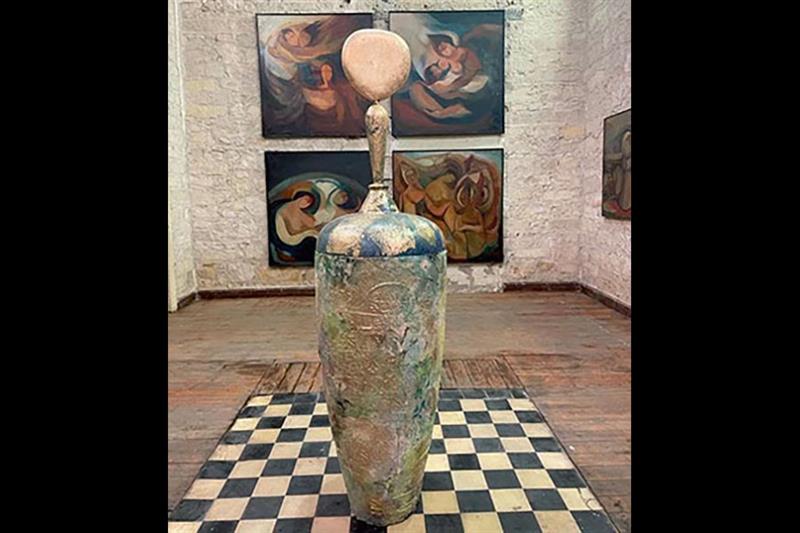The keeper of secrets: Artist Mohamed Abouelnaga documents Alexandria of the 1980s and 90s
Nevine Lamei, Wednesday 26 Jan 2022
In his new solo exhibition at Access gallery in downtown Cairo, artist Mohamed Abouelnaga walks down memory lane to the years he spent in Alexandria.

The title of the exhibition is self-explanatory; 'Abouelnaga 80s & 90s' points to the multidisciplinary artist's life and the inspirations for his work produced between 1983 and 1996.
This is indeed a significant period in Abouelnaga’s career, during which he experimented with different techniques and materials while multiplying his spiritual and metaphysical readings.
The influence of Alexandria’s sea and marine erosion dominate the work of the artist, who hailed from the town of Tanta, where he faced many visual stimuli, notably those of the feasts commemorating the great Sufi Al-Sayed Al-Badawi.
“Between 1983 and 1996, I mainly lived in Alexandria. When I arrived there to study fine arts, the coastal town welcomed me warmly. I experienced youthful enthusiasm, a true joie-de-vivre, fantasies, etc. I wanted to pay homage to that era,” Mohamed Abouelnaga said.
In the middle of the immense space of the Access gallery stands an installation titled Canopic Jar produced in 2021, bringing together all the works around it.
“The lid of my canopic jar represents the keeper of secrets and mysteries for the Ancient Egyptians. It has a mirror, reflecting the past and the present, a bit like me, contemplating my journey,” Abouelnaga explains.
On one of the walls of the gallery hangs the flagship work of the exhibition, which dates back to 1983. Titled Genesis, the work is one-and-a-half meters long and one-and-a-half meters wide. The painting, which was part of the artist's graduation project at the Fine Arts Academy in Alexandria, shows a mother breastfeeding her baby, inspired by an icon of Jesus and Mary, surrounded by a halo of light.
"Far from the chaos and difficulties that we encounter on a daily basis, especially with the pandemic, I decided to exhibit Genesis to calm our confused minds and find serenity," says the artist, who presents his own Genesis, his journey which led him to the ancient manuscripts and famous portraits of Fayoum, as well as to the old Christian, Hebrew and Muslim books.
"My Genesis is also synonymous with love, knowledge, friendship, freedom, beauty, desire, prohibitions, dreams, romanticism, human relationships... In short, so many things that I felt during my youthful years,” adds Abouelnaga.
Historical/legendary stories keep returning in the exhibition. The artist always likes to transcend myths, for instance in his paintings he is at times inspired by Egyptian funerary art. But we also see the flying bodies, erased faces, semi-naked women, rural, Coptic, and Islamic motifs and ornaments, etc.
Play with matter
During the 1990s, the artist was looking for new manufacturing processes, surrounding materials, driven by the desire to better manage industrial waste. Thus, in 1992, he mixed papier-mâché with his paintings for the first time resulting with the series Al-Guidar (The Wall).
In 1996, he traveled to Japan to deepen his knowledge of paper art, and as he explains, “paper is this basic material used for writing, printing and packaging, and it opens up many horizons for us to think about. It is the support of our ancestral memory. If the Ancient Egyptian used the elements of nature to make papyri, I in turn try to resuscitate the touch of antiquity by mixing paint with paper. I try to preserve the primitive aspect of the paper."
The artist presents four works from his Al-Guidar series, mixing paint, paper, natural pigments and other organic materials (tree leaves, cotton fibres, rice straw and wheat ears).
In this series, he is inspired by the compositions of Islamic manuscripts, or even the Maqamat of Yéhia Ibn Mahmoud, known as Al-Wassiti (a 13th century Arab painter and calligrapher from Iraq).
“From prehistory to contemporary art, the wall is the privileged place of artistic expression. A wall can also constitute a border. We talk about the wall of incomprehension, the wall of loneliness, lamentations, etc. The pasty layers in this series are matched and layered; they can act on our psyche,” Abouelnaga concludes.
The exhibition continues at Access gallery until 5 February.
No comments:
Post a Comment